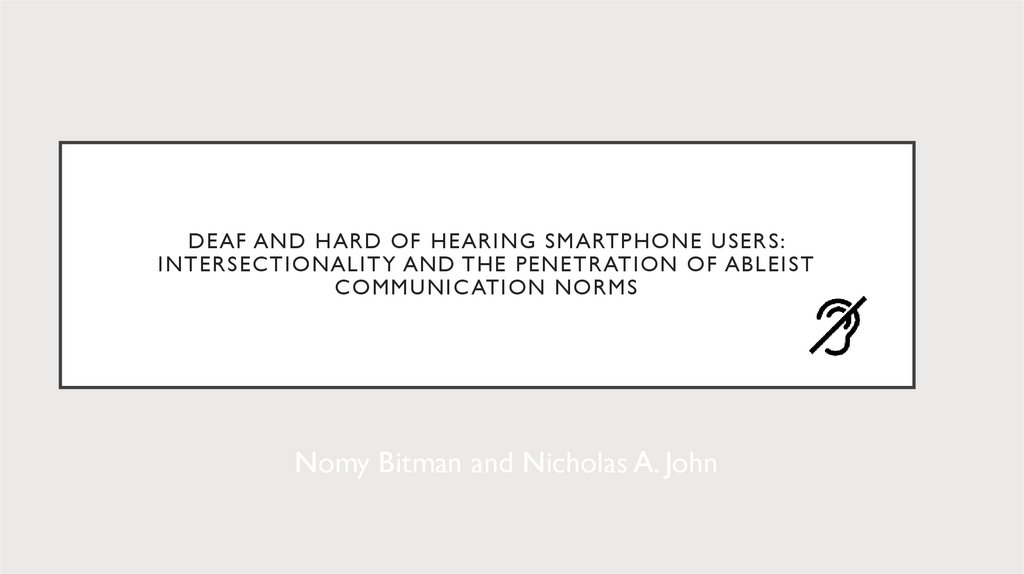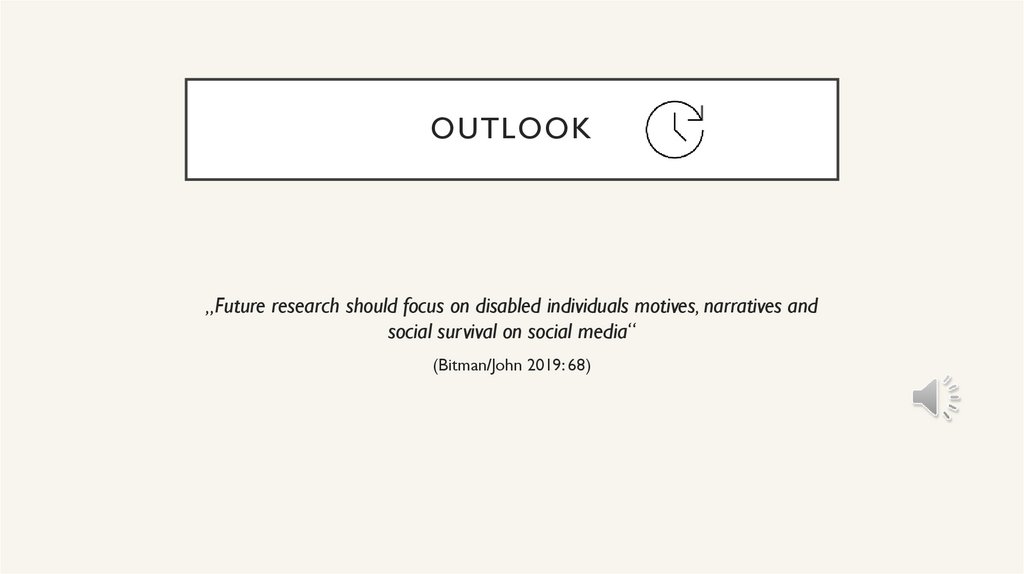Similar presentations:
Deaf and hard of hearing smartphone users: intersectionality and the penetration of ableist communication norms
1.
DE AF AND H AR D OF H E AR I NG SMART P H ONE USE R S:I NT E R SECTI ONALIT Y AND T H E P E NE T R ATION OF AB L E I ST
COMMUNI C ATI ON NOR MS
Nomy Bitman and Nicholas A. John
2.
AGENDA• Background information
• Communication Norms
• Technology and Disability
• Intersectionality
• Study
• Questions
• Method
• Findings
• Conclusion
• Outlook
3.
COMMUNICATION NORMS”This liberal humanist perspective defines those who are able to
speak “properly” as human and rational while marking others as
non normative”
• Ideal human communication: based on the use of spoken
language
• People who can’t hear can be excluded from society
4.
COMMUNICATION NORMS• Today’s communication is connected to “new media based practises”
• Use of “natural elements” in electronic communication (e.g voice calls)
instant feedback, language variety, constant reachability, emotional
attachment to medium, FOMO
Presumption of able-bodiedness and ignorance of people with
different communication needs: deaf and HoH people
Leads to stigmatisation of these groups because they do not have
the same “cultural communicative standards”
5.
COMMUNICATION NORMS• Able-bodiedness is seen as the standard
• Deaf and HoH people are expected to wear hearing aids, implants, and
to go to speech therapy
Speech should sound as “normal” as possible
Sign language is seen as non-normative
6.
TECHNOLOGY AND DISABILITY• Technology and especially smartphones have some accessible features
• But: Technology is designed by able-bodied people
• Disabled people are excluded
• Replication of oppression of different bodies
• Disability as product of able-bodied structures
7.
INTERSECTIONALITY• Intersectionality:
”This is where some source of oppression intersects with another
meaning that people who belong to more than one marginalised group may
suffer greater discrimination based on their cultural distance from the normal
body”
• Oppression can be possible because of:
• Gender
• Nationality
• Religion
8.
QUESTIONS• How do ableist norms of “hearing” communication interact
with assumptions of constant mobile reachability in shaping
deaf and HoH people’s smartphone use?
• And more importantly, how might the accessible features
of the smartphone themselves contribute to the social
oppression of disabled users, especially when they are part
of diverse social groups?
9.
METHOD• Study on perspective of disabled people themselves
• Person who identifies as HoH interviewed 20 people
• Participants: Israeli citizens between 19 and 72 who own a
smartphone
• Interviewees from different subgroups in Israel: Intersectional
analysis
• Because of communicative diversity - different types of
interviews
10.
FINDINGS“I think that hearing people expect me to reply quickly, right away – “Ariel, we’re in the middle of a
discussion, don’t disappear!”—and deaf people know that we exchange messages with fifty thousand
other people at a time, so they’re more relaxed (...) Hearing people get annoyed unless I reply (...)
because they are so used to the immediacy of voice calls. They tell me that the amount of texting gets
them down (...) that it’s really hard for them, so they say, “I wish I could send you recorded [voice]
messages on WhatsApp.” (...) but sometimes with men it’s quite cute, like “Wow, Ariel, I’d really like to
hear your voice. I miss you.” (Ariel, 34)
• Expectation of constant reachability and inclusion of “natural
elements”
• Expectation towards Women: normalcy and attractive
11.
FINDINGS“I try not to emphasize that I’m HoH, so that people won’t notice. I only mention it if people are
problematic or say something very unclearly. Then I say, “Sorry, could you repeat that?” without
explaining why (...) I don’t want to give rise to any stigma (...) Some people, for example, talk from
one corner of the room and their hands-free phone is far away (...) nobody, not even a hearing
person, could understand what they’re saying. I don’t have a hear- ing problem and I can hear
where the person is (...) And then I said: “Please pick up the phone and speak clearly, because I
(...)” He asked, “why?” And I replied, “because I can’t hear you well.” And then he said, “I didn’t know
that about you (...).” (Reuven)
• Fear of audistic stigma: so he uses voice calls to pass as hearing
• Pretends to be a hearing person - reflection of his internalisation of a
“normal body”
12.
FINDINGS”I was talking to someone on my mobile in order to schedule a docttor’s appointment. And then (...)
[my] babies (...) were crying but I couldn’t hear them, and the woman on the phone, and there was
someone else knocking at the door, and I didn’t hear either of them (...) and the hearing aid was
buzzing (...).Then I realized that someone was knocking on the door (...) and it was so
embarrassing when I saw it was my brother-in- law (...) I felt so embarrassed because he heard me
screaming on the phone and my children crying as well and (...) with all the background noise of
my crying children, the phone conversation and the knocking on my door, I had no idea that I was
yelling so loudly. ” (Jasmin, 30)
• Member of ultra orthodox society: expectation of taking care of
children and household
13.
FINDINGS“[Text] messages are a really nice way to communicate, but sometimes you need a
phone call as well. There are hard of hearing or deaf people who can’t make voice calls,
and that’s fine, so it’s important for them to have a good camera in order to be able to
talk face to face. For me, it’s important to have good sound, because I can more or less
get by. If I can get by [by turning the volume up] and I can talk, then I can’t give it up.
You have to train your brain to do this, to maintain [the ability to understand voice calls]
otherwise you lose it (...). “(Amir, 34)
• Perceived superiority: he differentiates himself from deaf people
• His critics echoes negative social perceptions in Arab society of deaf and HoH
persons
14.
CONCLUSION• Voice/video call as the most problematic function of smartphones
• Voice/video call becomes a mechanism of oppression
• Intersectional perspective
• interviewees had different responses and attitudes to the expectation to perform voice calls
• People of multiple marginalised groups (gender, age, sexuality, nationality, religiosity) are
more negatively affected by media technology
• HoH people try to separate themselves from deaf people and avoiding “coming out”
as disabled
15.
OUTLOOK„Future research should focus on disabled individuals motives, narratives and
social survival on social media“
(Bitman/John 2019: 68)















 medicine
medicine electronics
electronics








